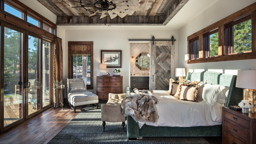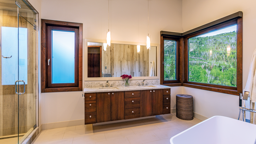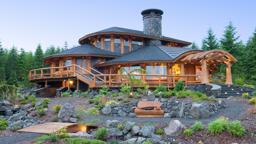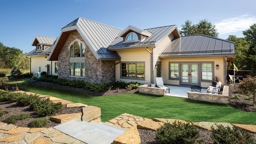The Question:
It seems like more and more homeowners are combining wood tones, paints and species in their homes. I love the look, but I’m afraid to make the wrong choices and create a design disaster. Is there a “secret sauce” formula that will let varying wood tones harmonize and keep them from clashing?
We turned to Michael Grant, designer/co-owner at Modern Rustic Homes in Georgia for the pro answer.
The Answer:
When working with wood, achieving the desired stain color can be a challenge and can confound even the most skilled applicator. Paint is easy because the color typically is opaque and conceals the material under it. Not so with stain.
Often I have clients asking for “contrasting” colors when what they really want are “complementing” colors. The contrast they’re seeking is usually light verses dark. This is easily achieved when we apply the same stain on two textures of wood, such as smooth-planed versus rough-sawn, circular-sawn or re-sawn wood. Smooth textures will not absorb stain as deeply, as the milled surface seals the wood cells. By contrast, rough or unsealed wood textures will absorb pigments deep into the fibers, thus providing the light/dark contrast.
When I use the same stain on rough-sawn rafters against a milled-wood plank ceiling, I get a beautiful complement of light and dark, but they are shades of one another. An example of this is the great room [pictured first in the gallery]. On the floor, you see a fair amount of red in the teak wood (get a closer look in the dining room [pictured last in the gallerry]). What works here is the way the red of the floors is hinted at in the knot pattern of the white pine wood planks in the ceiling, thus creating both complement and contrast.
Mixing stained finishes against painted finishes (as illustrated in the kitchen [pictured second in the gallery]) is much easier to manipulate. But that, too, can get tricky, as we have 50 shades of white, much less gray or any other color. In these situations, I try to keep the finishes within the same tonal values — either cool or warm.
Though mixing wood species in a room can create appealing contrast, mixing them in the same application is something to avoid. I first realized this when I had milled-wood moldings, one being spruce, and the other, maple. Needless to say, they were both planed smooth, but they took the stain completely differently. We ultimately had to dilute the stain 50/50 with water to apply to spruce, as the maple had such a tight grain it would not allow much stain penetration at all — even at full strength.
So how do you navigate stain applications to achieve the look you desire? Easy: Sample the stain color on the wood species and texture before committing to it.














